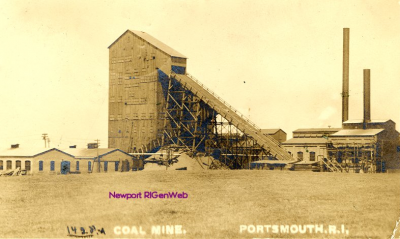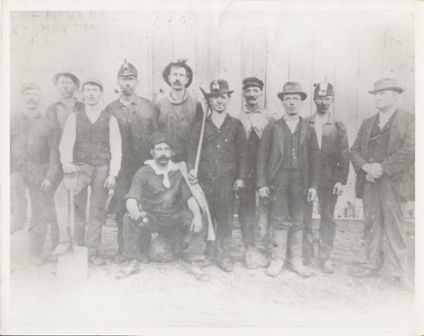 Portsmouth, RI Coal Mine
Portsmouth, RI Coal MineCOAL MINES BENEATH CARNEGIE ABBEY GOLF COURSE
PORTSMOUTH, RI - Most golfers at Carnegie Abbey Club are unaware that the water used to irrigate the golf course comes from miles and miles of abandoned coal mines running east/west from Narragansett Bay to East Main Rd. and north/south from Portsmouth town hall and to Melville Marina. Today, the mines contain an estimated 400 million gallons of fresh water. Carnegie Abbey's original developer briefly considered bottling this fresh water under a private Carnegie Abbey label.
HISTORY OF MINING PORTSMOUTH RI
In the early 19th century they were teeming with men and mules mining coal to fuel America's industrial revolution. The mules hauled the coal bins in and out of the mines. Local legend has it that some of these animals lived their entire lives underground.
 Inscription on back of photo to right: "Portsmouth Coal Miners. Photo - circa 1904. Tall man in center John W. Marshall on his right is Tom Hughes, the company clown & fiddler. Extreme right: Dr. Steele. Man kneeling: Souza (?)" Photo from The John T. Pierce, Sr., Portsmouth Historical Collection
Inscription on back of photo to right: "Portsmouth Coal Miners. Photo - circa 1904. Tall man in center John W. Marshall on his right is Tom Hughes, the company clown & fiddler. Extreme right: Dr. Steele. Man kneeling: Souza (?)" Photo from The John T. Pierce, Sr., Portsmouth Historical Collection
In 1809 rich deposits of coal were discovered in the northwest section of Portsmouth. They were mined on and off by a variety of companies including the Rhode Island Coal Company and the Aquidneck Coal Company. In 1866 a thriving copper smelting operation was established near the mines with 8 blast furnaces, 22 kilns, tenements, a store, a school house and a depot on the Old Colony Newport Railroad (a current stop for the Newport Dinner Train). The Taunton Copper Company thrived treating copper from the US and abroad.
Rhode Island coal was of poor quality* resulting in a series of corporate booms and busts until 1883 when the last ore was removed and the mines were abandoned. In 1909 new mines began serving a modern power plant. It closed four years later in 1913.
The luxury Carnegie Abbey Tower was adapted from the Kaiser Aluminum plant that fabricated aluminum and copper wire in the 60s and 70s. The area is still zoned "HI" or Heavy Industrial.
The legacy of Rhode Island's coal mines continues every time a sale is recorded in neighborhoods like Hilltop Estates where properties are transferred without their mineral rights. 150 years ago farmers sold these rights to the coal companies.
*Rhode Island coal is hard anthracite which burns very hot, but is much harder to ignite than the coal found in Pennsylvania, the more common softer bituminous variety.
Posted by Leslie Hogan on
Your description of Pennsylvania coal as more common bituminous variety is NEWS to us living in the Scranton / Pittston area.. We have a history of anthracite coal. I hope your local history does not / will not include Natural gas fracking!
Posted by Marty Dwyer on Friday, February 1st, 2013 at 4:16pmI lived on Aquidnexk island for more than a decade while working at the Navy Base.
Marty
Hi Marty,
Posted by Leslie Mathieu Hogan on Sunday, February 3rd, 2013 at 9:29amNo, no fracking in store for us. Our mining days are over here in RI, I'm afraid. The site of these mines is now a beautiful golf resort / club. As for the antrhacite, I'm sure you are correct. Thanks for your input, and I hope you get a chance to come back for a visit! L.
interesting on the mineral rights being sold. My father told me when he bought the land this house is on there were no mineral rights. From what I can piece together there was a coal mining company perhaps a mile or so north of here. This was all one large farm and the farmer was probably talked into selling the mineral rights for a song. Be interesting to know if that was a timed rights or forever rights. No I have not found oil, so I am not worried.
Posted by Bill Nelson on Wednesday, December 2nd, 2015 at 8:54pmLeave A Comment